The United States is home to a variety of birds in all shades of blue, from indigo to slate and sky blue to midnight. A great number of these beauties inhabit Ohio.
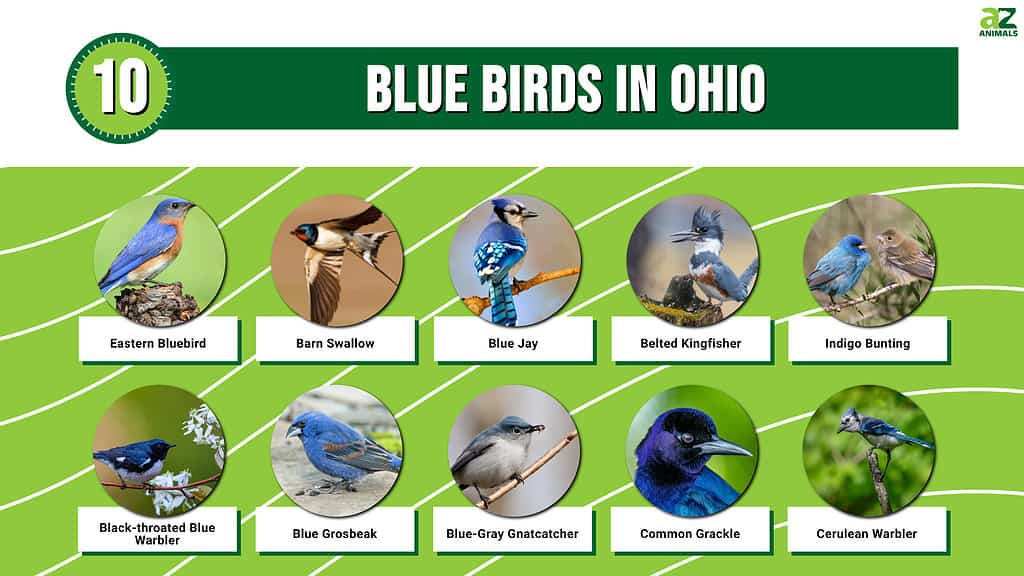
They live in forests, backyards, parks, and along coastlines, thriving in the thick understory and visiting bird feeders. Do you see a colorful bird you need help identifying? Use this handy guide for the ten most common blue birds in Ohio. Discover how to identify them, where they live, and how they behave.
Eastern Bluebird
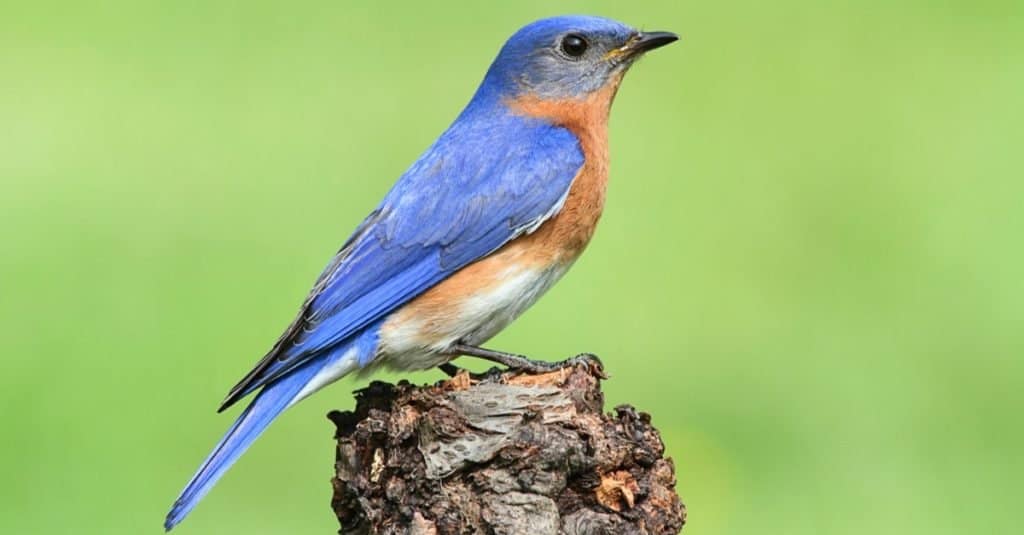
Eastern bluebirds inhabit the eastern half of the United States, with patchy distributions in Mexico and Central America.
©Steve Byland/Shutterstock.com
The eastern bluebird is a small thrush native to North America. They measure 6 to 8 inches long and feature sky blue heads, backs, wings, and tails, which contrast beautifully with their white undersides and brownish-red breasts. This species makes soft warbles and low-pitched melodious songs.
Eastern bluebirds inhabit the eastern half of the United States, with patchy distributions in Mexico and Central America. You can find them in open country near trees. Their preferred habitats include pine savannas, pastures, agricultural fields, parks, and backyards.
Look for them perched on wires and fence posts near an open field. And observe them as they fly to the ground to grab insects or swoop out to catch them mid-air. They also fly low to the ground with fast, irregular wingbeats.
Barn Swallow
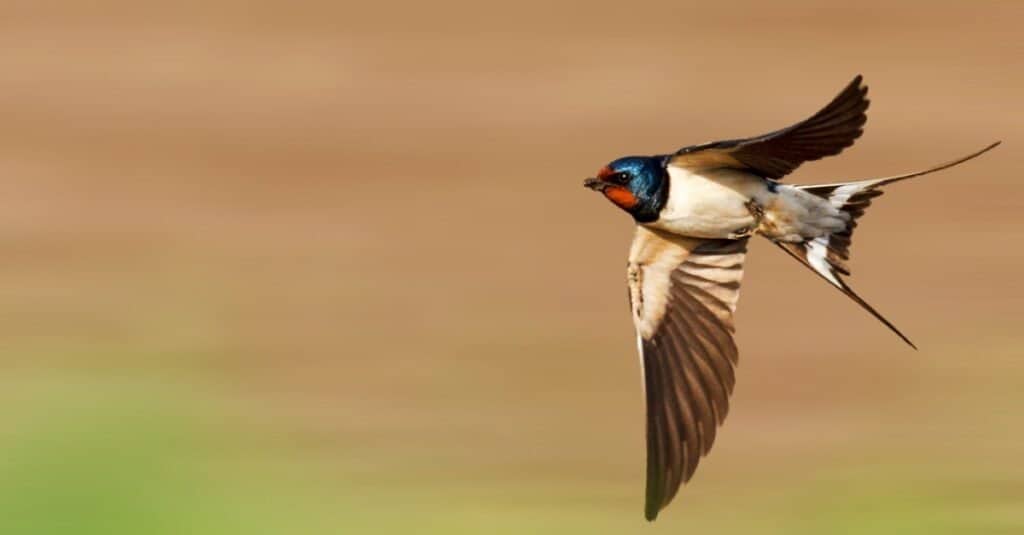
Swallows swoop down to scare threats before attacking.
©iStock.com/drakuliren
Barn swallows are the most widespread swallow species in the world and have the most significant natural distribution of any passerine. You can identify them by their shimmering steel blue heads and upperparts, white undersides, and rufous foreheads, chins, and throats. They also have a deeply forked “swallow tail,” with a line of white spots.
They inhabit every continent except Antarctica, and you can find them in most areas except deserts and the coldest regions in the north. Barn swallows have wide-ranging habitats, but you can primarily find them foraging in parks, agricultural fields, beaches, and over open water, like ponds and lakes.
These birds spend much of their time in the air, flying with smooth wingbeats low to the ground or skimming the water’s surface. They catch insects in mid-air but also occasionally forage by plucking prey from the ground. You can often find them near humans and cattle, searching for flushed insects.
Blue Jay
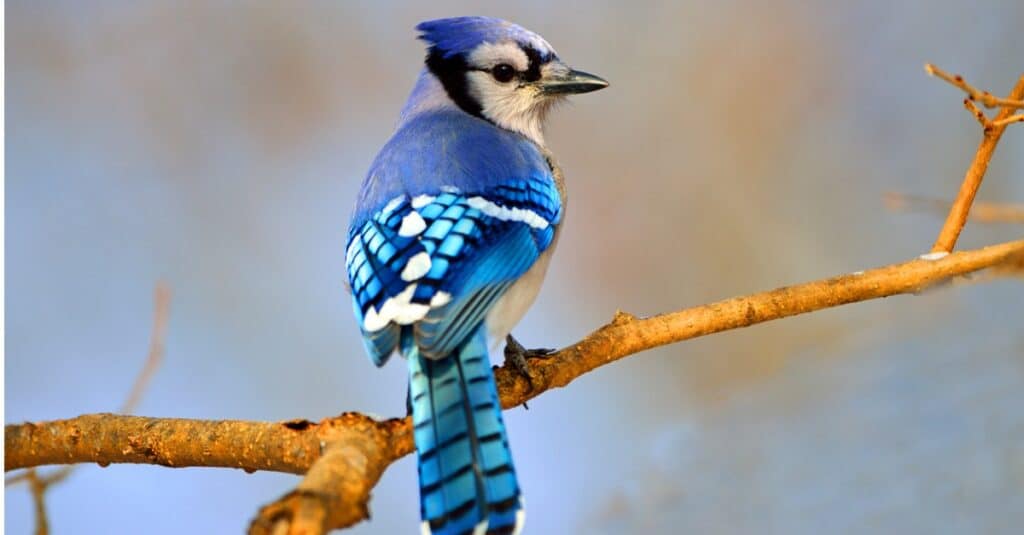
Their plumage is a mix of medium blue, sky blue, and white on the head, back, wings, and tail.
©iStock.com/BrianEKushner
The blue jay is a large songbird native to North America. It measures between 9 and 12 inches on average and has a pronounced crest. Most notably, these stunning birds have intensely blue feathers in a variety of shades. The crest is typically flattened against its head but raises when the bird is excited or aggressive. Their plumage is a mix of medium blue to pale, baby blue. They are white on the head, back, wings, and tail. And their undersides and faces are white with black markings.
This species lives year-round in the eastern half of Canada and the United States, with some populations dispersing to the northwest during nonbreeding seasons. They live in forests, especially near oak trees. You can also find them in urban and suburban areas at bird feeders. These birds like tray feeders or hopper feeders on a post, with peanuts, sunflower seeds, and suet.
Belted Kingfisher

Kingfishers are a subtle greyish blue on their heads, backs, and wings.
©Harry Collins Photography/Shutterstock.com
Belted kingfishers are large water kingfishers native to North America. These stocky birds measure between 11 to 14 inches long, with the females being slighter larger than the males. This species features a shaggy crest and a large head. Adults are a subtle greyish blue on their heads, backs, and wings. And they have white undersides and white collars around their necks.
They live throughout most of Canada, the United States, Mexico, and Central America. But you can also find them in the northern tip of South America. Their preferred habitats include streams, rivers, lakes, ponds, and estuaries. They nest in the banks near the water and fish from the same location. In the winter, you can also find them in swamps, mangroves, and brackish lagoons. These birds occasionally make their way into backyards that contain goldfish pools.
Indigo Bunting
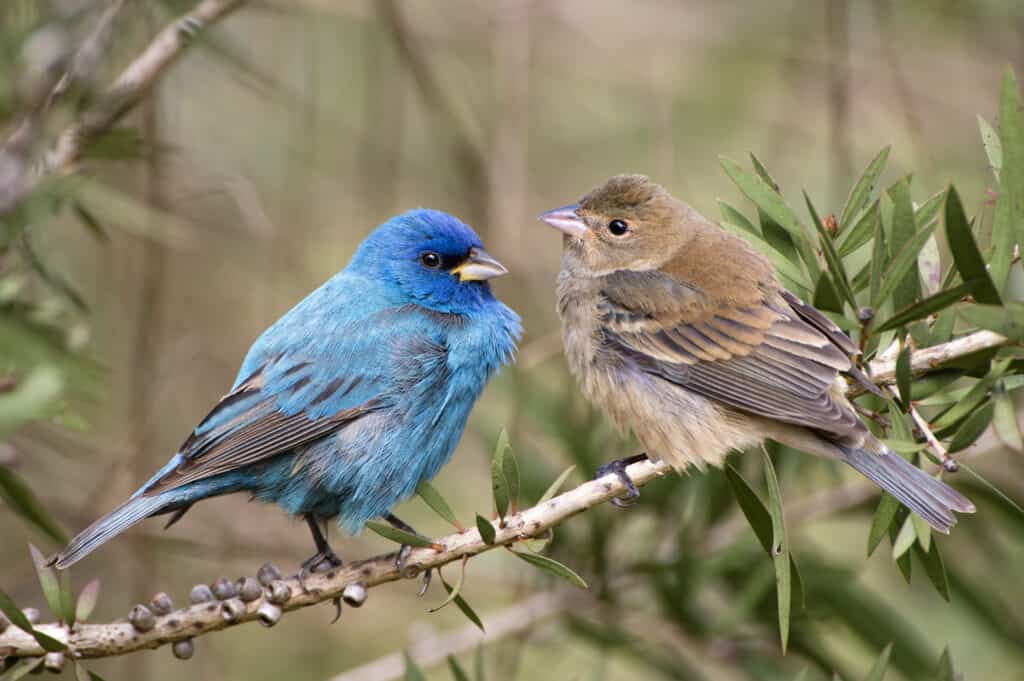
Males are bright indigo in the summer and brown during winter, while females are brown year-round.
©Bonnie Taylor Barry/Shutterstock.com
The indigo bunting is a small bird from the cardinal family native to North and South America. They average between 4.5 to 5 inches in length and feature sexual dimorphism. Males are bright indigo in the summer and brown during winter, while females are brown year-round. They make sharp chirps and high-pitched buzzy calls while in flight or when threatened.
They breed primarily in the eastern half of the United States and winter in Central America, the West Indies, and the northern tip of South America. Their preferred habitats include open deciduous woods, farmlands, and forest edges. They forage insects, seeds, and berries on the ground or in shrubs and trees. Their summer diet consists mainly of insects, while they primarily eat seeds in winter.
Black-throated Blue Warbler

Their upper plumage is a deep ocean or midnight blue.
©iStock.com/BrianLasenby
Black-throated blue warblers are small passerines native to North America. They measure 5 inches in length with 7-inch wingspans. As their name suggests, adult males have black throats, faces, and flanks. Their upper plumage is a deep ocean or midnight blue, while their undersides are white. Females are olive brown above and yellow below.
This species breeds in southeastern Canada and the northeastern United States and winters in southern Florida, the West Indies, and Central America. They live in mature forests in temperate climates, inhabiting the thick understory. In its breeding grounds, you can find them in mountainous regions. And during the winter, they inhabit tropical woodlands. Look for them in low vegetation foraging for invertebrates, seeds, berries, and fruits.
Blue Grosbeak
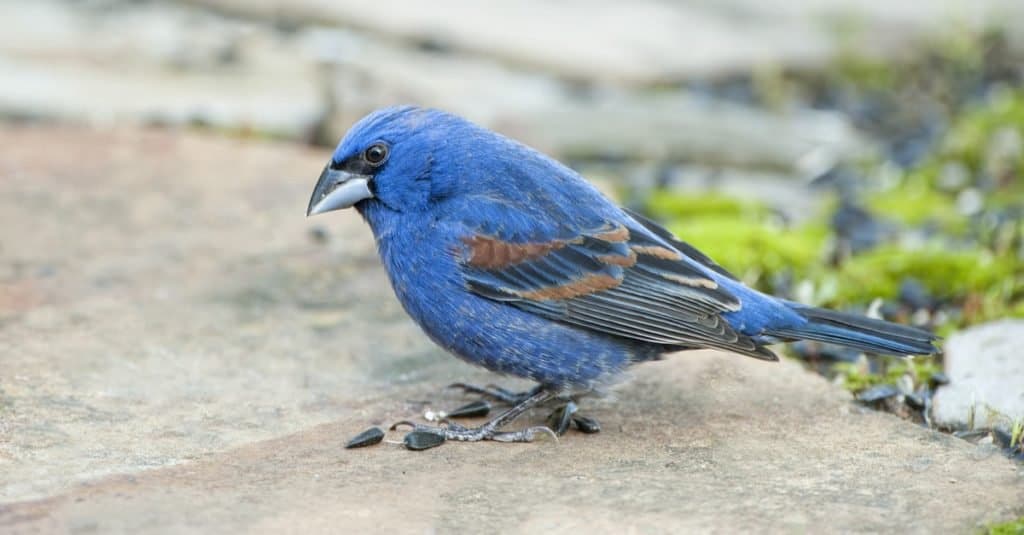
You will often find blue grosbeaks near the edge of an open area.
©Bonnie Taylor Barry/Shutterstock.com
Blue grosbeaks are medium-sized passerines from the cardinal family. Their length varies between 5 and 7 inches, and the males are mostly vivid sky blue with brown and black on their wings. This species is sexually dimorphic, and females are brown with black on their wings and tails.
They breed in the southern half of the United States and Mexico and winter in Central America. But some populations in warm habitats stay year-round in their environment. Their preferred habitat includes woodlands, scrubs, overgrown fields, and thickets. You will often find them near the edge of an open area, nesting in low trees and bushes. They forage on the ground, searching for insects, snails, spiders, seeds, and fruits.
Blue-Gray Gnatcatcher
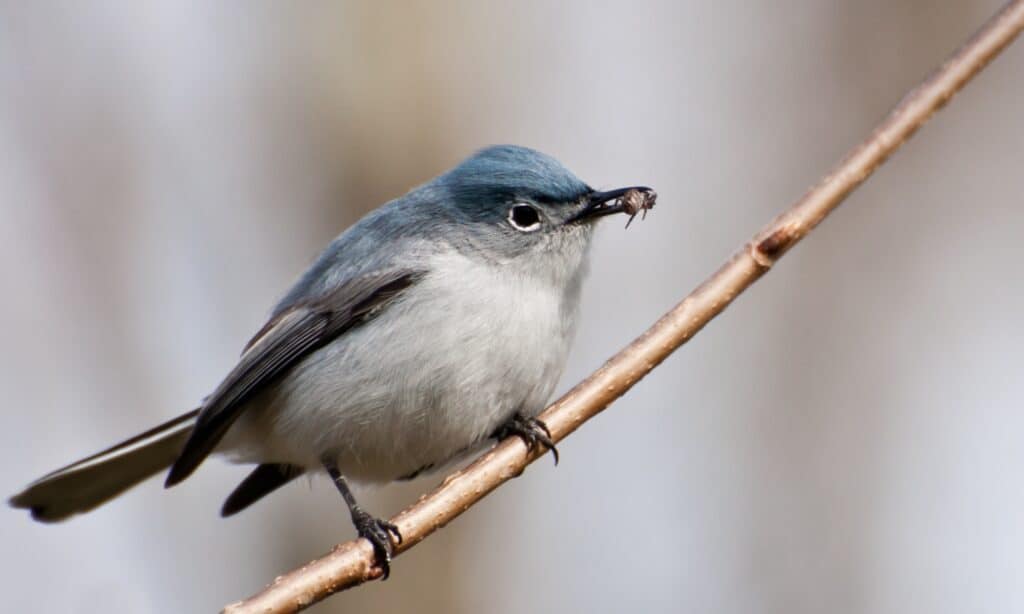
Gnatcatchers forage by hovering over trees and shrubs, snatching prey like insects and spiders.
©iStock.com/JasonOndreicka
The blue-gray gnatcatcher is a tiny songbird from North America. It measures 3 to 5 inches long and weighs between 0.18 and 0.25 ounces. Their upperparts are a muted bluish-gray, and their undersides are white. They also feature slender bills and long black tails. And their white eye rings are distinctive.
This species breeds throughout most of the United States except for the far northern regions. And they winter or live year-round in Mexico, southern Florida, and Central America. They breed in open woodlands and shrublands and prefer humid regions with large foliage. Gnatcatchers forage by hovering over trees and shrubs, snatching insects and spiders. They are often spotted with their tails in upright positions when feeding or defending their territory.
Common Grackle
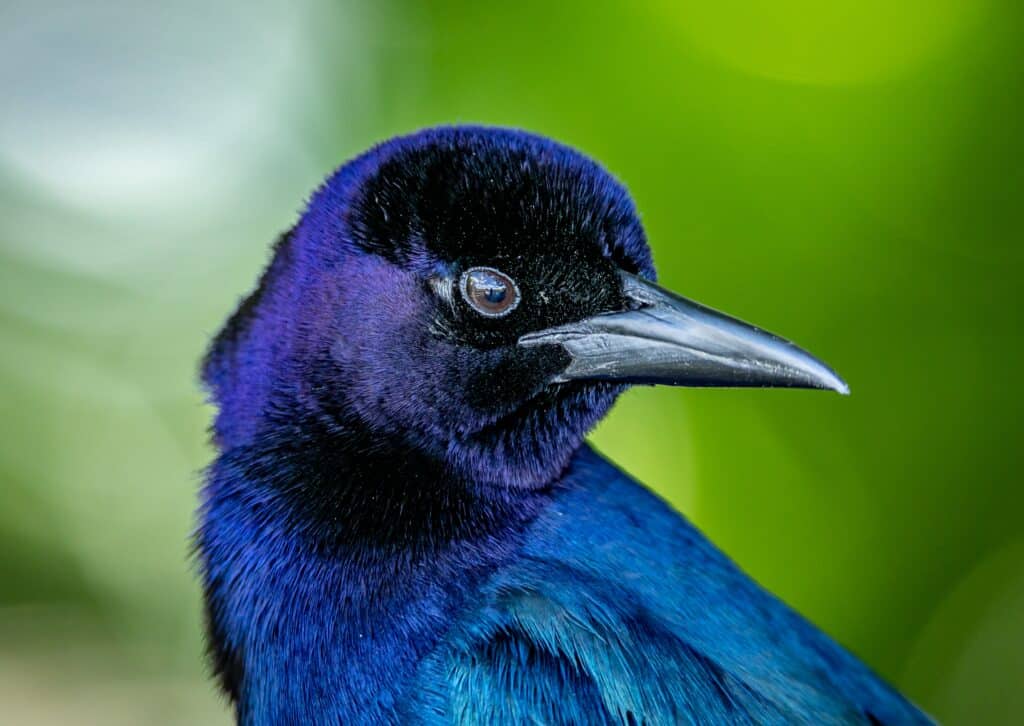
The common grackle has an iridescent royal purple-blue head.
©Holly S. Cannon/Shutterstock.com
Common grackles are large birds from the Icterid, or blackbird, family. They measure 11 to 13 inches and have 14 to 18-inch wingspans. Adult males are black with bronze bodies and stunningly iridescent royal purple- blue heads. Females look similar but somewhat smaller and have less iridescence.
They live year-round in the eastern half of the United States, but populations that breed in southern Canada migrate to the southeastern US. Their habitats include semi-open areas like woodlands, grasslands, meadows, swamps, and marshes. But they also do well near humans in agricultural fields, city parks, and suburbs. These noisy birds spend their lives in blackbird flocks, foraging on the ground and roosting in tall trees. They can form colonies of up to 200 pairs.
Cerulean Warbler
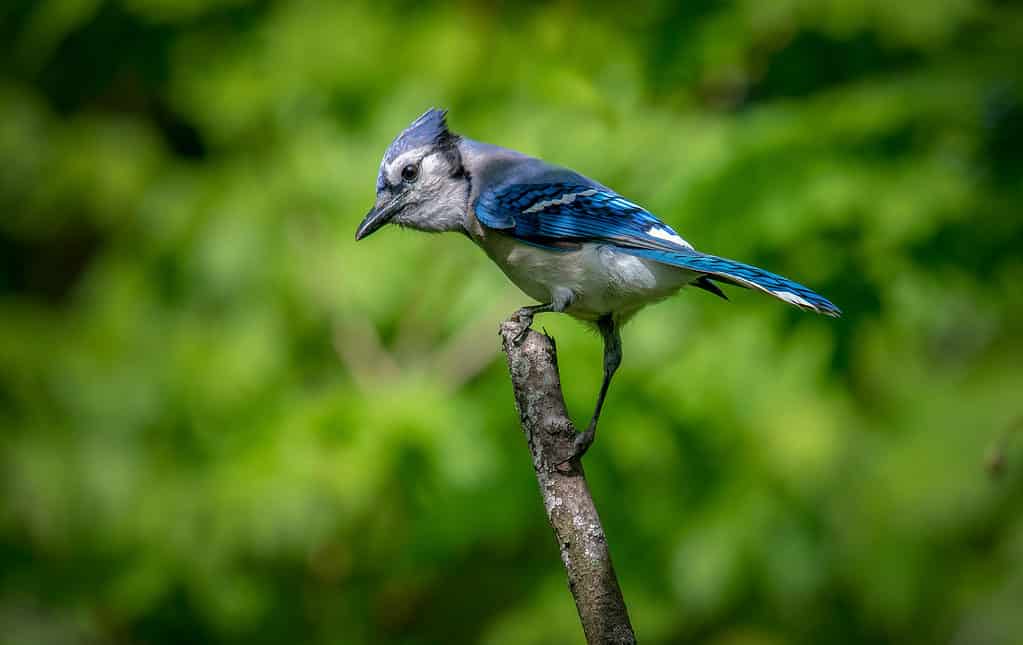
Aptly named, their top feathers are an electric cerulean blue!
©Jeff Rzepka/Shutterstock.com
Cerulean warblers are small songbirds in North and South America. They average 4 inches long with 8-inch wingspans. Males are bigger than females and they have white bellies, with dark bills and white breast bands. Aptly named, their top feathers are an electric cerulean blue!
This species breeds in the northeastern United States, migrates through the central US and Central America, and winters in South America. They live on large tracts of land in mature deciduous forests. In their winter habitats, you can find them in woodlands, evergreen forests, and on coffee plantations.
Summary of 10 Blue Birds in Ohio
| Name of Bird | Length in Inches | Habitat |
|---|---|---|
| Eastern Bluebird | 6-8 | Pine savannas, pastures, agricultural fields, parks, and backyards. |
| Barn Swallow | 5.5-7 | Parks, agricultural fields, beaches, and over open water, like ponds and lakes. |
| Blue Jay | 9-12 | Forests, especially near oak trees. |
| Belted Kingfisher | 11-14 | Streams, rivers, lakes, ponds, and estuaries. |
| Indigo Bunting | 4.5-5 | Open deciduous woods, farmlands, and forest edges. |
| Black-throated Blue Warbler | 5 | Breed in mature forests in temperate climates, inhabiting the thick understory; winter in tropical woodlands. |
| Blue Grosbeak | 5-7 | Woodlands, scrubs, overgrown fields, and thickets. |
| Blue-Gray Gnatcatcher | 3-5 | Woodlands and shrublands; prefer humid regions with large foliage. |
| Common Grackle | 11-13 | Woodlands, grasslands, meadows, swamps, and marshes. |
| Cerulean Warbler | 4 | Mature deciduous forests in spring/summer. In winter, woodlands, evergreen forests, and coffee plantations. |
The photo featured at the top of this post is © Jan Stria/Shutterstock.com
Sources
- Cornell.edu / Accessed December 8, 2022
- IUCN Redlist / Accessed December 8, 2022
Thank you for reading! Have some feedback for us? Contact the AZ Animals editorial team.







